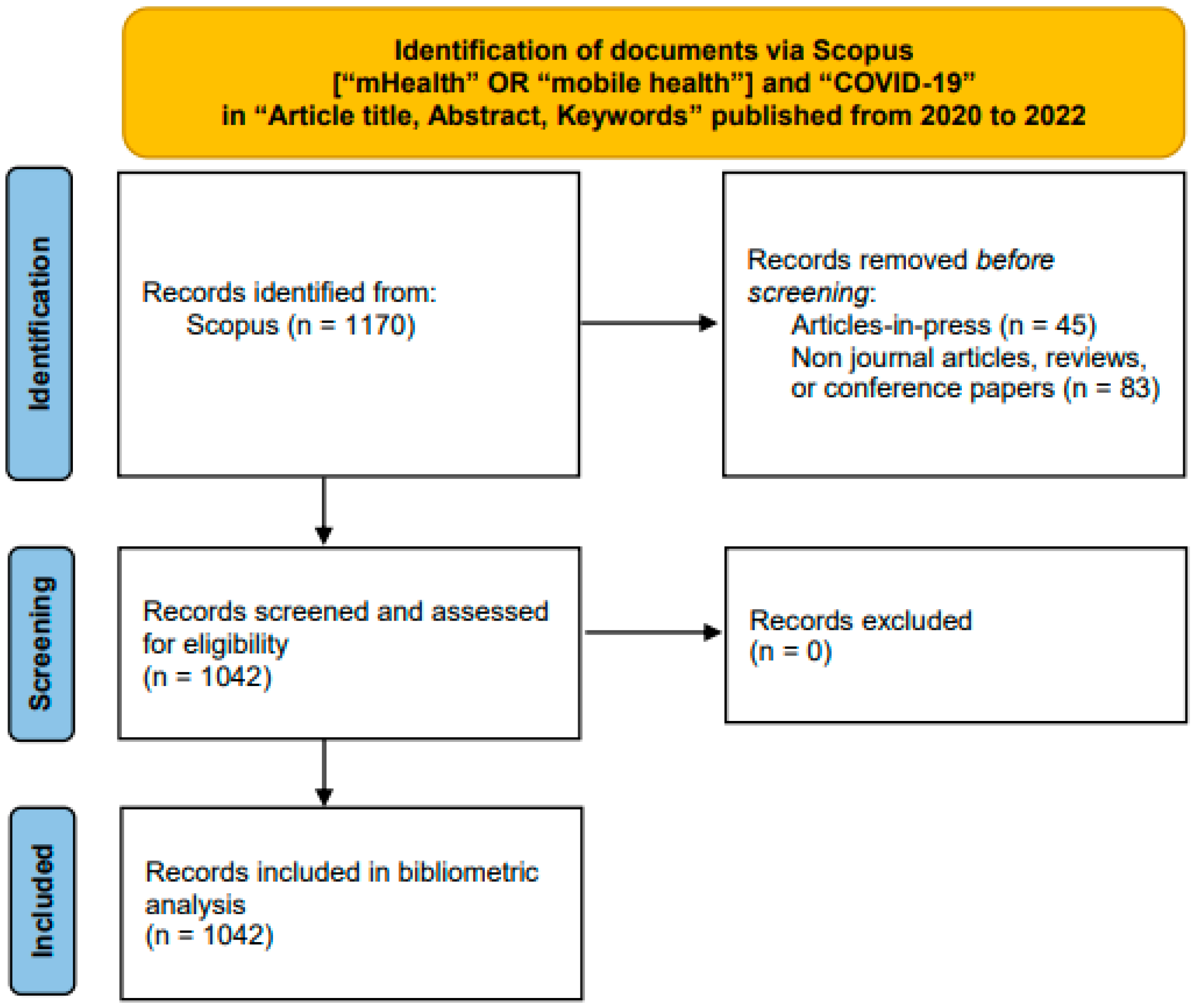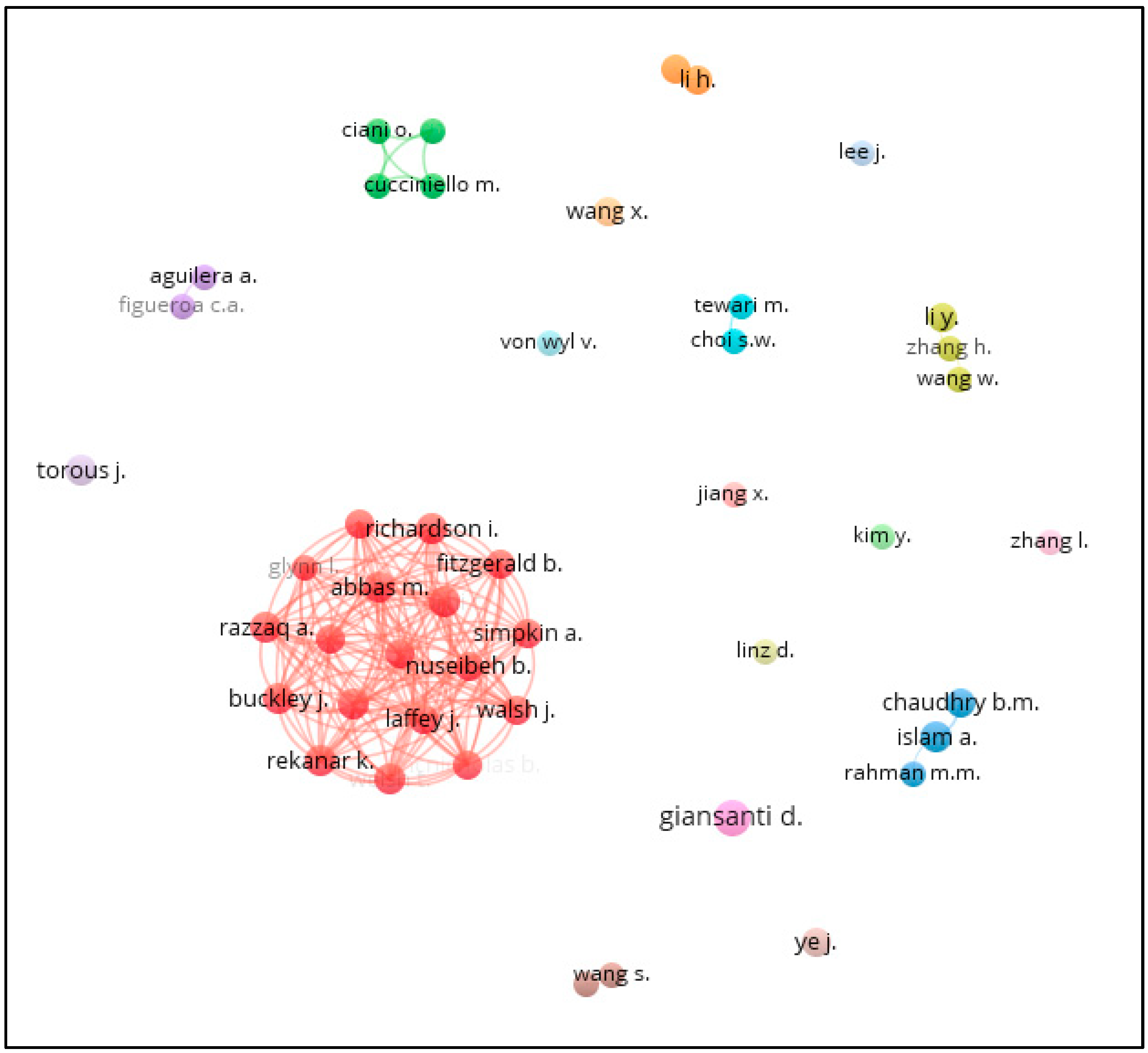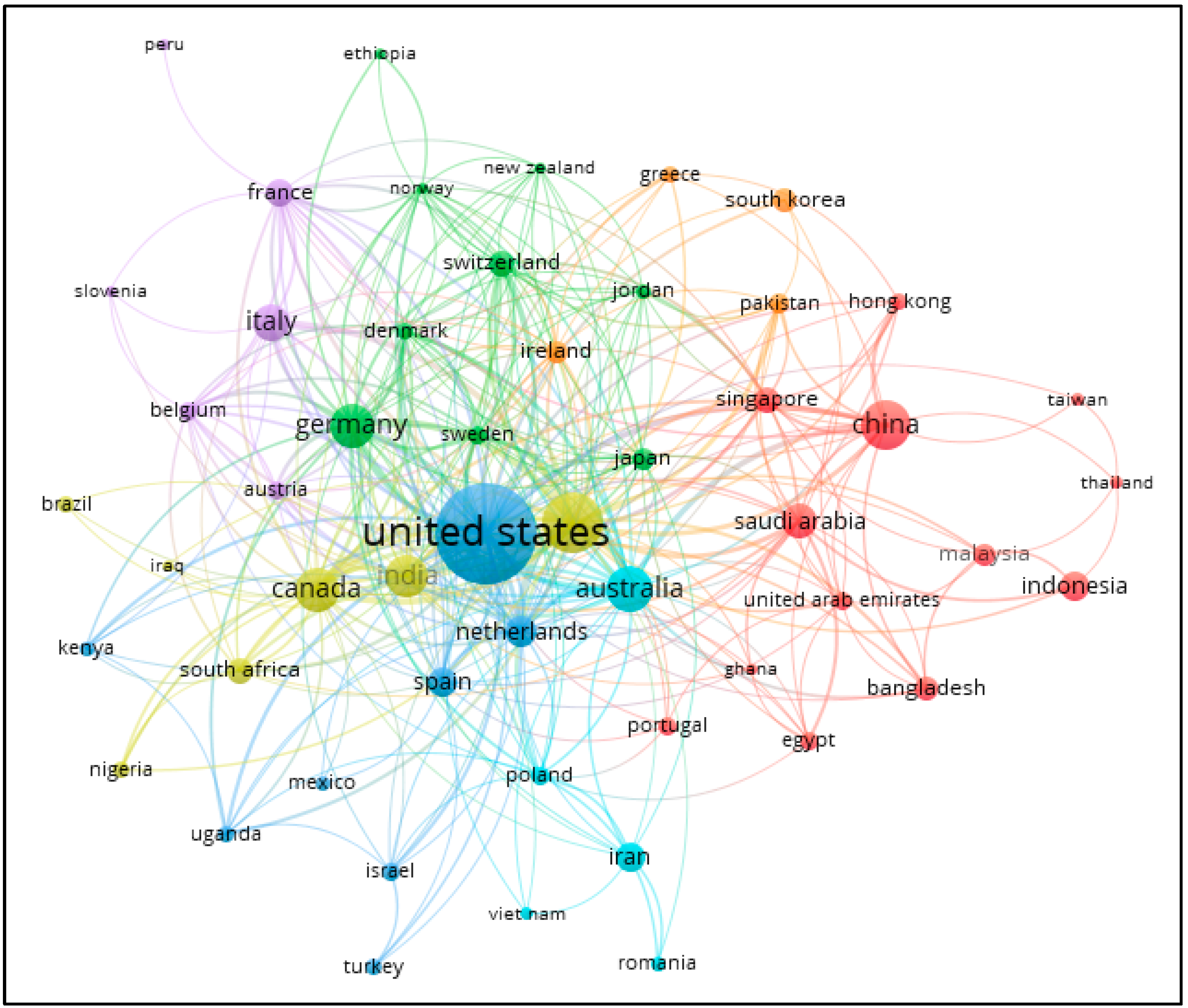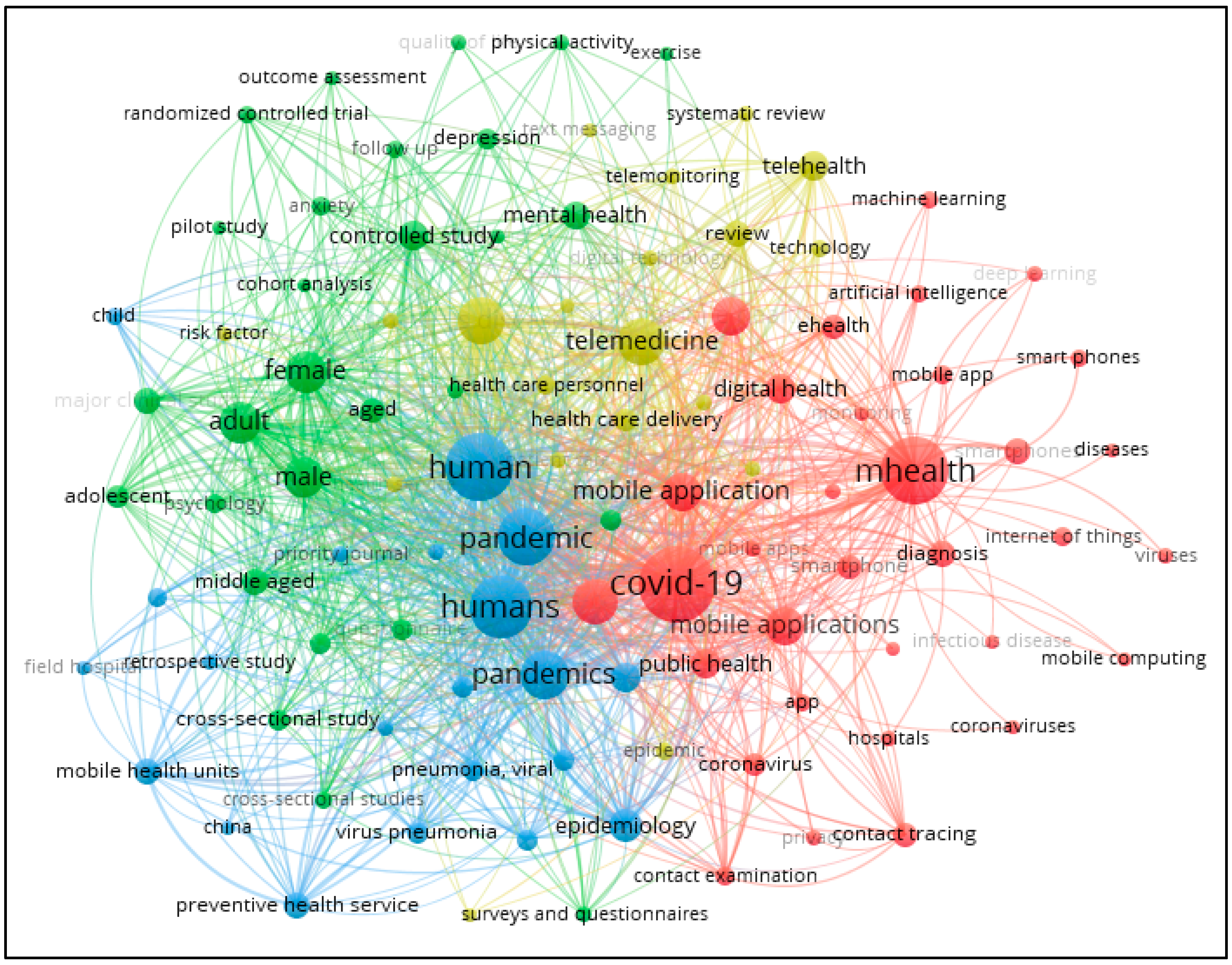mHealth and COVID-19: A Bibliometric Study
Abstract
1. Introduction
2. mHealth, COVID-19, and Bibliometric Analysis
2.1. Reviews of mHealth and COVID-19
2.2. Systematic Review and Bibliometric Analysis
3. Materials and Methods
3.1. Materials
3.2. Methods
4. Results
4.1. Performance Analysis Using Scopus Tools
4.2. Science Mapping Using VOSviewer
5. Discussion
6. Conclusions
Author Contributions
Funding
Institutional Review Board Statement
Informed Consent Statement
Data Availability Statement
Conflicts of Interest
References
- Free, C.; Phillips, G.; Felix, L.; Galli, L.; Patel, V.; Edwards, P. The effectiveness of M-health technologies for improving health and health services: A systematic review protocol. BMC Res. Notes 2010, 3, 250. [Google Scholar] [CrossRef] [PubMed]
- Fiordelli, M.; Diviani, N.; Schulz, P.J. Mapping mHealth research: A decade of evolution. J. Med. Internet Res. 2013, 15, e2430. [Google Scholar] [CrossRef] [PubMed]
- To, W.M.; Lee, P.K.C.; Lu, J.; Wang, J.; Yang, Y.; Yu, Q. What motivates Chinese young adults to use mHealth? Healthcare 2019, 7, 156. [Google Scholar] [CrossRef] [PubMed]
- Cao, J.; Zhang, G.; Liu, D. The impact of using mHealth apps on improving public health satisfaction during the COVID-19 pandemic: A digital content value chain perspective. Healthcare 2022, 10, 479. [Google Scholar] [CrossRef] [PubMed]
- McGarrigle, L.; Todd, C. Promotion of physical activity in older people using mHealth and eHealth technologies: Rapid review of reviews. J. Med. Internet Res. 2020, 22, e22201. [Google Scholar] [CrossRef]
- Dauletbaev, N.; Oftring, S.Z.; Akik, W.; Michaelis-Braun, L.; Korel, J.; Lands, L.C.; Waldmann, S.; Muller, B.S.; Dreher, M.; Rohde, G.; et al. A scoping review of mHealth monitoring of pediatric bronchial asthma before and during COVID-19 pandemic. Paediatr. Respir. Rev. 2022, 43, 67–77. [Google Scholar] [CrossRef]
- Messner, E.M.; Sturm, N.; Terhorst, Y.; Sander, L.B.; Schultchen, D.; Portenhauser, A.; Schmidbaur, S.; Stach, M.; Klaus, J.; Baumeister, B.; et al. Mobile apps for the management of gastrointestinal diseases: Systematic search and evaluation within app stores. J. Med. Internet Res. 2022, 24, e37497. [Google Scholar] [CrossRef]
- Rauschenberg, C.; Schick, A.; Hirjak, D.; Seidler, A.; Paetzold, I.; Apfelbacher, C.; Riedel-Heller, S.G.; Reininghaus, U. Evidence synthesis of digital interventions to mitigate the negative impact of the COVID-19 pandemic on public mental health: Rapid meta-review. J. Med. Internet Res. 2021, 23, e23365. [Google Scholar] [CrossRef]
- El-Sherif, D.M.; Abouzid, M. Analysis of mHealth research: Mapping the relationship between mobile apps technology and healthcare during COVID-19 outbreak. Glob. Health 2022, 18, 67. [Google Scholar] [CrossRef]
- Moher, D.; Liberati, A.; Tetzlaff, J.; Altman, D.G.; PRISMA Group. Preferred reporting items for systematic reviews and meta-analyses: The PRISMA statement. Ann. Intern. Med. 2009, 151, 264–269. [Google Scholar] [CrossRef]
- Tran, K.; Buchanan, J.; Song, Y.J.C.; Rosenberg, S.; Occhipinti, J.A.; Hickie, I.B. A mental wealth perspective: Crossing disciplines to understand the value of collective mental and social assets in the post-COVID-19 era. Int. J. Ment. Health Syst. 2022, 16, 56. [Google Scholar] [CrossRef] [PubMed]
- Pepper, C.; Reyes-Cruz, G.; Pena, A.R.; Dowthwaite, L.; Babbage, C.M.; Wagner, H.; Nichele, E.; Fischer, J.E. Understanding trust and changes in use after a year with the NHS COVID-19 contact tracing app in the United Kingdom: Longitudinal mixed methods study. J. Med. Internet Res. 2022, 24, e40558. [Google Scholar] [CrossRef] [PubMed]
- Swindon, P. Almost 14,000 Scots Have Disabled Coronavirus Contact Tracing App Protect Scotland. The Sunday Post. 18 July 2021. Available online: https://www.sundaypost.com/fp/disabled-coronavirus-app/ (accessed on 13 January 2023).
- Chung, C. Coronavirus Pandemic COVID News: C.D.C. Drops Contact Tracing Recommendation. The New York Times. 2 March 2022. Available online: https://www.nytimes.com/live/2022/03/02/world/covid-19-tests-cases-vaccine (accessed on 13 January 2023).
- Kouis, P.; Michanikou, A.; Anagnostopoulou, P.; Galanakis, E.; Michaelidou, E.; Dimitriou, H.; Matthaiou, A.M.; Kinni, P.; Achilleos, S.; Zacharatos, H.; et al. Use of wearable sensors to assess compliance of asthmatic children in response to lockdown measures for the COVID-19 epidemic. Sci. Rep. 2021, 11, 5895. [Google Scholar] [CrossRef]
- To, W.M.; Yu, B.T.W. Rise in higher education researchers and academic publications. Emerald Open Res. 2020, 2, 3. [Google Scholar] [CrossRef]
- Linnenluecke, M.K.; Marrone, M.; Singh, A.K. Conducting systematic literature reviews and bibliometric analyses. Aust. J. Manag. 2020, 45, 175–194. [Google Scholar] [CrossRef]
- Mulrow, C.D. Systematic reviews: Rationale for systematic reviews. BMJ 1994, 309, 597–599. [Google Scholar] [CrossRef]
- Cho, S.H.; Shin, I.S. Evaluation of the reporting standard guidelines of network meta-analyses in physical therapy: A systematic review. Healthcare 2022, 10, 2371. [Google Scholar] [CrossRef]
- Page, M.J.; Moher, D.; Bossuyt, P.M.; Boutron, I.; Hoffmann, T.C.; Mulrow, C.D.; Shamseer, L.; Telzlaff, J.M.; Akl, E.A.; Brennan, S.E.; et al. PRISMA 2020 explanation and elaboration: Updated guidance and exemplars for reporting systematic reviews. BMJ 2021, 372, n160. [Google Scholar] [CrossRef]
- Rethlefsen, M.L.; Page, M.J. PRISMA 2020 and PRISMA-S: Common questions on tracking records and the flow diagram. J. Med. Libr. Assoc. 2022, 110, 253–257. [Google Scholar]
- Donthu, N.; Kumar, S.; Mukherjee, D.; Pandey, N.; Lim, W.M. How to conduct a bibliometric analysis: An overview and guidelines. J. Bus. Res. 2021, 133, 285–296. [Google Scholar] [CrossRef]
- Baas, J.; Schotten, M.; Plume, A.; Côté, G.; Karimi, R. Scopus as a curated, high-quality bibliometric data source for academic research in quantitative science studies. Quant. Sci. Stud. 2020, 1, 377–386. [Google Scholar] [CrossRef]
- To, W.M. A bibliometric analysis of world issues—Social, political, economic, and environmental dimensions. World 2022, 3, 34. [Google Scholar] [CrossRef]
- Scopus. Scopus Database; Elsevier: Amsterdam, The Netherlands, 2023. [Google Scholar]
- Okubo, Y. Bibliometric Indicators and Analysis of Research Systems: Methods and Examples; OECD Science, Technology and Industry Working Papers—1997/01; OECD Publishing: Paris, France, 1997. [Google Scholar]
- Van Eck, N.; Waltman, L. Software survey: VOSviewer, a computer program for bibliometric mapping. Scientometrics 2010, 84, 523–538. [Google Scholar] [CrossRef] [PubMed]
- Van Eck, N.J.; Waltman, L. Manual for VOSviewer, version 1.6.10; CWTS Universiteit Leiden: Leiden, The Netherlands, 2019.
- Polsinelli, M.; Cinque, L.; Placidi, G. A light CNN for detecting COVID-19 from CT scans of the chest. Pattern Recognit. Lett. 2020, 140, 95–100. [Google Scholar] [CrossRef] [PubMed]
- Ahmed, N.; Michelin, R.A.; Xue, W.; Ruj, S.; Malaney, R.; Kanhere, S.S.; Seneviratne, A.; Hu, W.; Janicke, H.; Jha, S.K. A survey of COVID-19 contact tracing apps. IEEE Access 2020, 8, 134577–134601. [Google Scholar] [CrossRef]
- Altmann, S.; Milsom, L.; Zillessen, H.; Blasone, R.; Gerdon, F.; Bach, R.; Kreuter, F.; Nosenzo, D.; Toussaert, S.; Abeler, J. Acceptability of app-based contact tracing for COVID-19: Cross-country survey study. JMIR Mhealth Uhealth 2020, 8, e19857. [Google Scholar] [CrossRef]
- Badawy, S.M.; Radovic, A. Digital approaches to remote pediatric health care delivery during the COVID-19 pandemic: Existing evidence and a call for further research. JMIR Pediatr. Parent. 2020, 3, e20049. [Google Scholar] [CrossRef]
- Liu, D.; Ju, C.; Han, C.; Shi, R.; Chen, X.; Duan, D.; Yan, J.; Yan, X. Nanozyme chemiluminescence paper test for rapid and sensitive detection of SARS-CoV-2 antigen. Biosens. Bioelectron. 2021, 173, 112817. [Google Scholar] [CrossRef]
- Figueroa, C.A.; Aguilera, A. The need for a mental health technology revolution in the COVID-19 pandemic. Front. Psychiatry 2020, 11, 523. [Google Scholar] [CrossRef]
- Ding, X.; Clifton, D.; Ji, N.; Lovell, N.H.; Bonato, P.; Chen, W.; Yu, X.; Xue, Z.; Xiang, T.; Long, X.; et al. Wearable sensing and telehealth technology with potential applications in the coronavirus pandemic. IEEE Rev. Biomed. Eng. 2021, 14, 48–70. [Google Scholar] [CrossRef]
- Chandir, S.; Siddiqi, D.A.; Mehmood, M.; Setayesh, H.; Siddique, M.; Mirza, A.; Soundardjee, R.; Dharma, V.K.; Shah, M.T.; Abdullah, S.; et al. Impact of COVID-19 pandemic response on uptake of routine immunizations in Sindh, Pakistan: An analysis of provincial electronic immunization registry data. Vaccine 2020, 38, 7146–7155. [Google Scholar] [CrossRef] [PubMed]
- Torous, J.; Bucci, S.; Bell, I.H.; Kessing, L.V.; Faurholt-Jepsen, M.; Whelan, P.; Carvalho, A.F.; Keshavan, M.; Linardon, J.; Firth, J. The growing field of digital psychiatry: Current evidence and the future of apps, social media, chatbots, and virtual reality. World Psychiatry 2021, 20, 318–335. [Google Scholar] [CrossRef]
- Vedaei, S.S.; Fotovvat, A.; Mohebbian, M.R.; Rahman, G.M.E.; Wahid, K.A.; Babyn, P.; Marateb, H.R.; Mansourian, M.; Sami, R. COVID-SAFE: An IoT-based system for automated health monitoring and surveillance in post-pandemic life. IEEE Access 2020, 8, 188538. [Google Scholar] [CrossRef] [PubMed]
- Torous, J.; Myrick, K.J.; Rauseo-Ricupero, N.; Firth, J. Digital mental health and COVID-19: Using technology today to accelerate the curve on access and quality tomorrow. JMIR Ment. Health 2020, 7, e18848. [Google Scholar] [CrossRef] [PubMed]
- Spitzer, R.L.; Kroenke, K.; Williams, J.B.; Löwe, B. A brief measure for assessing generalized anxiety disorder: The GAD-7. Arch. Intern. Med. 2006, 166, 1092–1097. [Google Scholar] [CrossRef]
- Latif, S.; Rana, R.; Qadir, J.; Ali, A.; Imran, M.A.; Younis, M.S. Mobile health in the developing world: Review of literature and lessons from a case study. IEEE Access 2017, 5, 11540–11556. [Google Scholar] [CrossRef]
- El-Sherif, D.M.; Abouzid, M.; Elzarif, M.T.; Ahmed, A.A.; Albakri, A.; Alshehri, M.M. Telehealth and artificial intelligence insights into healthcare during the COVID-19 pandemic. Healthcare 2022, 10, 385. [Google Scholar] [CrossRef]




| Rank | Affiliation (University/Hospital) | Publications |
|---|---|---|
| 1 | Harvard Medical School | 31 |
| 2 | University College London | 21 |
| 3 | Massachusetts General Hospital | 20 |
| 4 | King’s College London | 16 |
| 5 | University of California, San Francisco | 15 |
| 6 | University of Toronto | 14 |
| 6 | UNSW Sydney | 14 |
| 8 | Johns Hopkins University | 12 |
| 8 | Imperial College London | 12 |
| 8 | University of Washington | 12 |
| 8 | Brigham and Women’s Hospital | 12 |
| 8 | National University of Singapore | 12 |
| 8 | University of Michigan, Ann Arbor | 12 |
| Rank | Country | Publications |
|---|---|---|
| 1 | United States | 335 |
| 2 | United Kingdom | 119 |
| 3 | China | 79 |
| 4 | Australia | 70 |
| 5 | Canada | 66 |
| 6 | Germany | 65 |
| 7 | India | 57 |
| 8 | Italy | 46 |
| 9 | Saudi Arabia | 39 |
| 10 | Netherlands | 34 |
| Rank | Funding Sponsor | Publications |
|---|---|---|
| 1 | National Institutes of Health | 75 |
| 2 | National Center for Advancing Tran. Sci. | 18 |
| 3 | National Institute of Mental Health | 18 |
| 4 | Canadian Institutes of Health Research | 15 |
| 5 | Horizon 2020 Framework Programme | 15 |
| 6 | National Natural Science Foundation of Canada | 13 |
| 7 | Bundesministerium fur Bildung und Forschung | 12 |
| 8 | European Commission | 12 |
| 9 | National Cancer Institute | 11 |
| 10 | National Research Foundation of Korea | 10 |
| Rank | Subject Area | Publications |
|---|---|---|
| 1 | Medicine | 717 |
| 2 | Computer Science | 253 |
| 3 | Engineering | 172 |
| 4 | Health Professions | 97 |
| 5 | Social Sciences | 65 |
| 6 | Decision Sciences | 62 |
| 7 | Nursing | 59 |
| 8 | Biochemistry, Genetics and Mol. Biology | 47 |
| 9 | Environmental Science | 45 |
| 10 | Mathematics | 44 |
| Rank | Source Title | Publications |
|---|---|---|
| 1 | JMIR Formative Research | 55 |
| 2 | Journal of Medical Internet Research | 52 |
| 3 | JMIR mHealth and uHealth | 50 |
| 4 | JMIR Research Protocols | 38 |
| 5 | Int. J. Environ. Res. and Public Health | 35 |
| 6 | Frontiers in Public Health | 21 |
| 7 | Studies in Health Tech. and Informatics | 16 |
| 8 | IEEE Access | 13 |
| 9 | Lecture Notes in Computer Science | 12 |
| 10 | PLOS ONE | 12 |
| Author(s) | Title | Year | Source | Citations |
|---|---|---|---|---|
| Polsinelli et al. [29] | A light CNN for detecting COVID-19 from CT scans of the chest | 2020 | Pattern Recognition Letters | 573 |
| Ahmed et al. [30] | A survey of COVID-19 contact tracing apps | 2020 | IEEE Access | 337 |
| Altmann et al. [31] | Acceptability of app-based contact tracing for COVID-19: cross-country survey study | 2020 | JMIR mHealth and uHealth | 187 |
| Badawy and Radovic [32] | Digital approaches to remote pediatric health care delivery during the COVID-19 pandemic: existing evidence and a call for further research | 2020 | JMIR Pediatrics and Parenting | 121 |
| Liu et al. [33] | Nanoyme chemiluminescence paper test for rapid and sensitive detection of SARS-CoV-2 antigen | 2021 | Biosensors and Bioelectronics | 117 |
| Figueroa and Aguilera [34] | The need for a mental health technology revolution in the COVID-19 pandemic | 2020 | Frontiers in Psychiatry | 101 |
| Ding et al. [35] | Wearable sensing and telehealth technology with potential applications in the Coronavirus pandemic | 2021 | IEEE Reviews in Biomedical Engineering | 99 |
| Chandir et al. [36] | Impact of COVID-19 pandemic response on uptake of routine immunizations in Sindh, Pakistan: an analysis of provincial electronic immunization registry data | 2020 | Vaccine | 95 |
| Torous et al. [37] | The growing field of digital psychiatry: current evidence and the future of apps, social media, chatbots, and virtual reality | 2021 | World Psychiatry | 91 |
| Vedaei et al. [38] | COVID-SAFE: an IoT-based system for automated health monitoring and surveillance in post-pandemic life | 2020 | IEEE Access | 90 |
| Cluster 1 | Cluster 2 | Cluster 3 | Cluster 4 |
|---|---|---|---|
| COVID-19 (727) | female (229) | human (581) | telemedicine (279) |
| mHealth (594) | adult (218) | humans (501) | coronavirus disease 2019 (273) |
| SARS-CoV-2 (269) | male (203) | pandemic (410) | telehealth (120) |
| mobile application (192) | controlled study (118) | pandemics (309) | review (89) |
| mobile health (185) | mental health (103) | epidemiology (147) | health care delivery (72) |
| mobile applications (182) | major clinical study (93) | procedures (108) | health care personnel (52) |
| digital health (119) | middle aged (91) | mobile health units (95) | epidemic (44) |
| public health (117) | aged (83) | preventive health service (93) | technology (42) |
| diagnosis (95) | adolescent (65) | virus pneumonia (62) | digital technology (37) |
| smartphones (91) | mobile phone (61) | pneumonia, viral (61) | health care (37) |
Disclaimer/Publisher’s Note: The statements, opinions and data contained in all publications are solely those of the individual author(s) and contributor(s) and not of MDPI and/or the editor(s). MDPI and/or the editor(s) disclaim responsibility for any injury to people or property resulting from any ideas, methods, instructions or products referred to in the content. |
© 2023 by the authors. Licensee MDPI, Basel, Switzerland. This article is an open access article distributed under the terms and conditions of the Creative Commons Attribution (CC BY) license (https://creativecommons.org/licenses/by/4.0/).
Share and Cite
To, W.-M.; Lee, P.K.C. mHealth and COVID-19: A Bibliometric Study. Healthcare 2023, 11, 1163. https://doi.org/10.3390/healthcare11081163
To W-M, Lee PKC. mHealth and COVID-19: A Bibliometric Study. Healthcare. 2023; 11(8):1163. https://doi.org/10.3390/healthcare11081163
Chicago/Turabian StyleTo, Wai-Ming, and Peter K. C. Lee. 2023. "mHealth and COVID-19: A Bibliometric Study" Healthcare 11, no. 8: 1163. https://doi.org/10.3390/healthcare11081163
APA StyleTo, W.-M., & Lee, P. K. C. (2023). mHealth and COVID-19: A Bibliometric Study. Healthcare, 11(8), 1163. https://doi.org/10.3390/healthcare11081163







